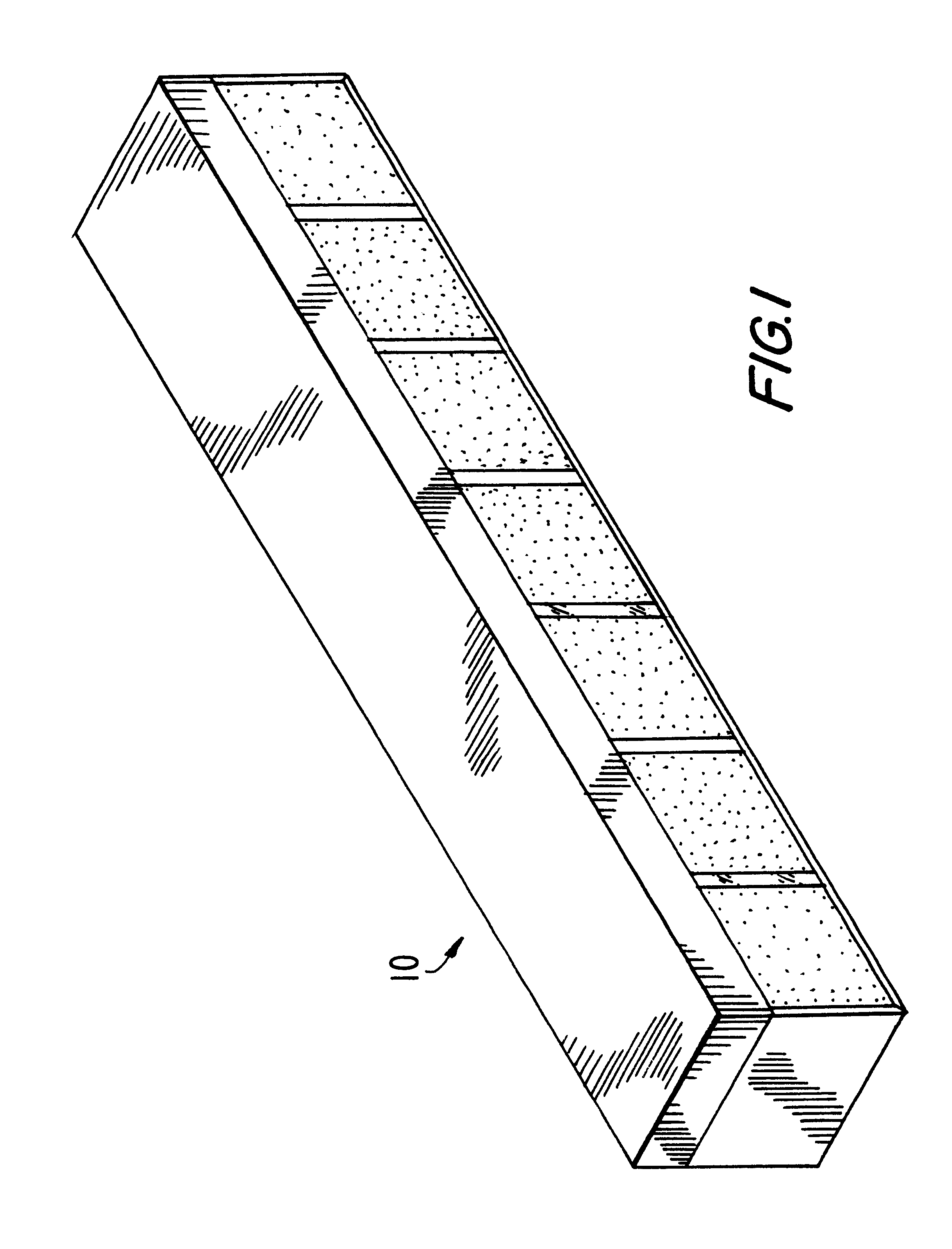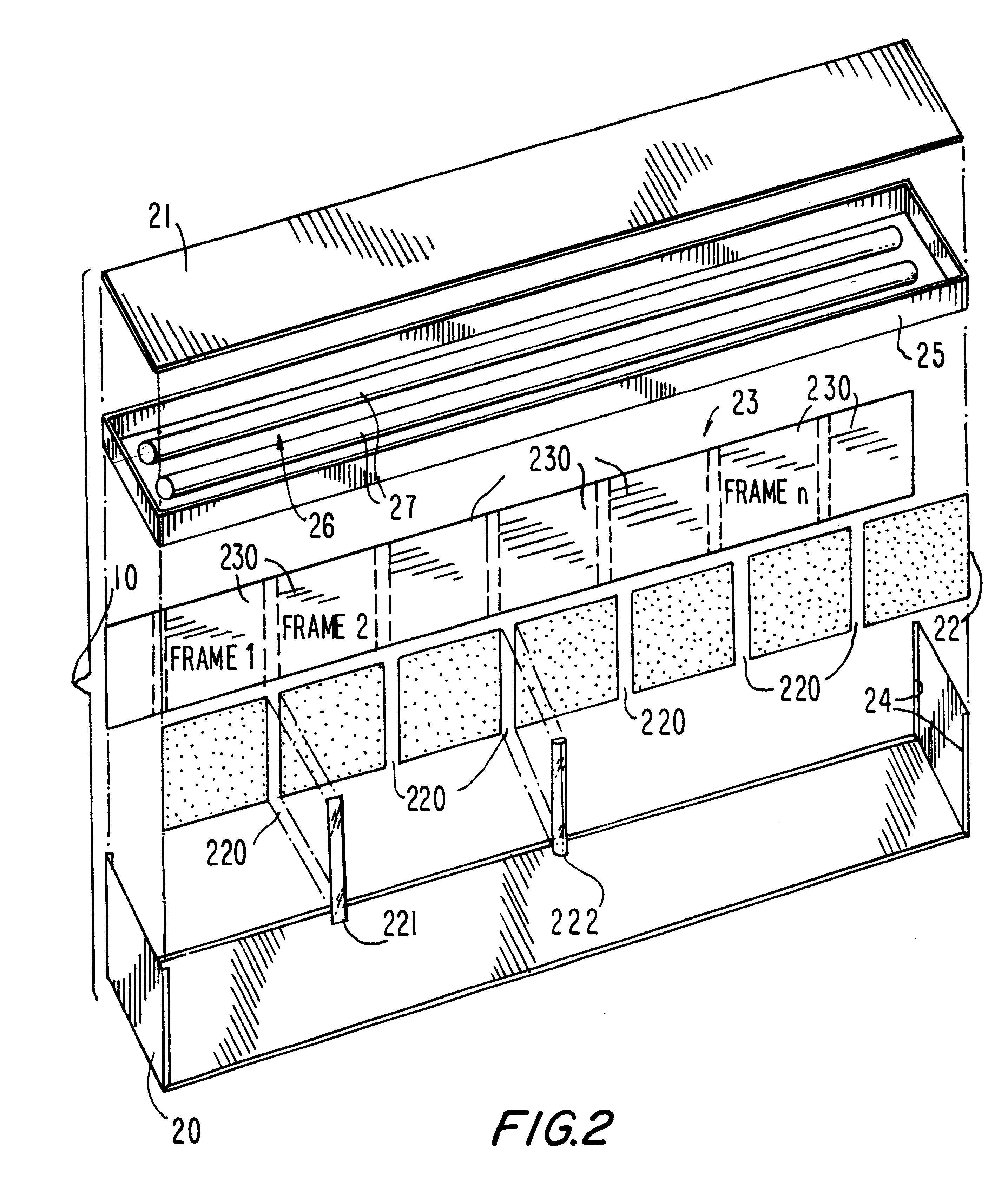Apparatus for displaying images to viewers in motion
a technology for displaying images and objects, applied in the direction of display means, advertisements, instruments, etc., can solve the problems of increasing the complexity and cost increasing the complexity of mechanical or electrical equipment, etc., and achieve the effect of altering the stretching
- Summary
- Abstract
- Description
- Claims
- Application Information
AI Technical Summary
Benefits of technology
Problems solved by technology
Method used
Image
Examples
example 2
The second example illustrates how the constraints tighten when near the minimal frame rate. To find the lowest practicable V.sub.w, assume the following parameters:
frame rate.apprxeq.20 frames / sec
D.sub.bs.apprxeq.6 inch
D.sub.vs.apprxeq.6 feet
D.sub.i '.apprxeq.2 feet.
By Relation (1),
D.sub.i =(D.sub.bs.times.D.sub.i ') / D.sub.vs =(0.5 ft.times.2 ft) / 6 ft=2 inches.
For abutted images, D.sub.ff =D.sub.i, and,
V.sub.w =D.sub.ff.times.frame rate=2 inches.times.20 frames / sec=40 inches / sec,
which is approximately pedestrian footspeed.
The implication of this last result--that the device can successfully display quality animations to pedestrian traffic--vastly increases the potential applicability of this device relative to stroboscopically based arrangements.
The following alternative preferred embodiments are within the spirit and scope of the invention.
FIG. 8 illustrates another preferred embodiment 80 altering the optimal viewing angle of the animation. In apparatus 80, backboard 83 bears ima...
embodiment 120
FIG. 12 shows another embodiment 120 similar to apparatus 100, but having a set of curved images 1230 (as in FIG. 7) facing slits 220 of opposite slitboards / backboards 101, 102. Apparatus 120 thus has characteristics, and advantages, of both apparatus 70 and apparatus 100.
FIG. 13 illustrates a roller type of image display mechanism 130 that may be placed at the position of the backboard. The rollers may contain a plurality of sets of images that can be changed by simply rolling from one set of images to another. Such a mechanism allows the changing of images to be greatly simplified. In order to change from one animation to another, instead of manually changing each image, one may roll such rollers to a different set of images. This change could be performed manually or automatically, for instance by a timer. By incorporating slits 220, mechanism 130 can be used in apparatus 100 or apparatus 120.
embodiment 140
Yet another preferred embodiment 140 is shown in FIGS. 14 and 15. In apparatus 140, "backboard" 141, with its images 142, is placed between viewer 30 and a series of mirrors 143. Each mirror 143 preferably is substantially the same size and orientation as any slits that would have been used in the aforementioned embodiments. Mirrors 143 preferably are mounted on a board 144 that takes the place of the slitboard, but mirrors 143 could be mounted individually or on any other suitable mounting. The principles of operation of apparatus 140 are substantially the same as those for the aforementioned embodiments. However, because "backboard" 141 would obscure the sight of mirrors 143 by viewer 30, "backboard" 141 may be placed above or below the line of sight of viewer 30. As shown in FIGS. 14 and 15, "backboard" 141 is above the line of sight of viewer 30. As drawn in FIGS. 14 and 15, moreover, both "backboard" 141 and "mirrorboard" 144 are inclined. However, with proper placement, inclin...
PUM
 Login to View More
Login to View More Abstract
Description
Claims
Application Information
 Login to View More
Login to View More - R&D
- Intellectual Property
- Life Sciences
- Materials
- Tech Scout
- Unparalleled Data Quality
- Higher Quality Content
- 60% Fewer Hallucinations
Browse by: Latest US Patents, China's latest patents, Technical Efficacy Thesaurus, Application Domain, Technology Topic, Popular Technical Reports.
© 2025 PatSnap. All rights reserved.Legal|Privacy policy|Modern Slavery Act Transparency Statement|Sitemap|About US| Contact US: help@patsnap.com



